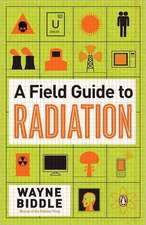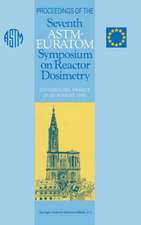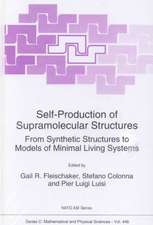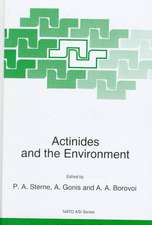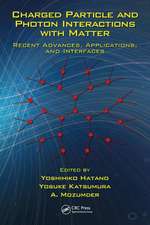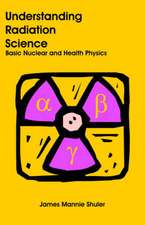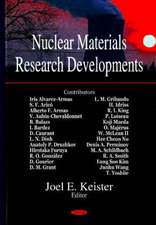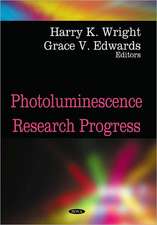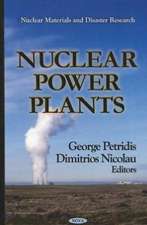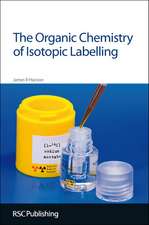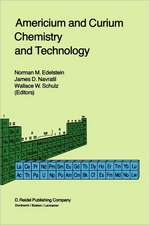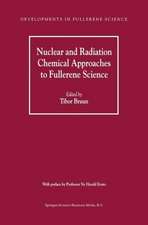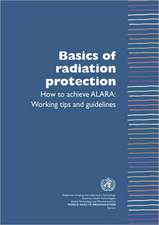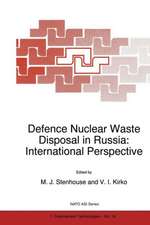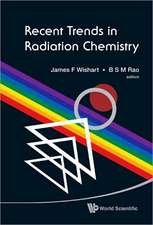Radioactive Particles in the Environment: NATO Science for Peace and Security Series C: Environmental Security
Editat de Deborah Oughton, Valery Kashparoven Limba Engleză Paperback – 23 dec 2009
| Toate formatele și edițiile | Preț | Express |
|---|---|---|
| Paperback (1) | 1216.95 lei 43-57 zile | |
| SPRINGER NETHERLANDS – 23 dec 2009 | 1216.95 lei 43-57 zile | |
| Hardback (1) | 1222.94 lei 43-57 zile | |
| SPRINGER NETHERLANDS – 10 aug 2009 | 1222.94 lei 43-57 zile |
Din seria NATO Science for Peace and Security Series C: Environmental Security
- 18%
 Preț: 1106.00 lei
Preț: 1106.00 lei - 15%
 Preț: 659.70 lei
Preț: 659.70 lei - 18%
 Preț: 999.60 lei
Preț: 999.60 lei - 18%
 Preț: 1221.07 lei
Preț: 1221.07 lei - 18%
 Preț: 1220.75 lei
Preț: 1220.75 lei - 18%
 Preț: 940.39 lei
Preț: 940.39 lei - 18%
 Preț: 1216.78 lei
Preț: 1216.78 lei - 18%
 Preț: 1232.71 lei
Preț: 1232.71 lei - 18%
 Preț: 1818.02 lei
Preț: 1818.02 lei - 18%
 Preț: 1833.95 lei
Preț: 1833.95 lei - 18%
 Preț: 1231.47 lei
Preț: 1231.47 lei - 18%
 Preț: 942.44 lei
Preț: 942.44 lei - 18%
 Preț: 1218.06 lei
Preț: 1218.06 lei - 18%
 Preț: 1383.00 lei
Preț: 1383.00 lei - 15%
 Preț: 664.29 lei
Preț: 664.29 lei - 18%
 Preț: 1220.88 lei
Preț: 1220.88 lei - 24%
 Preț: 1040.03 lei
Preț: 1040.03 lei - 18%
 Preț: 1222.80 lei
Preț: 1222.80 lei - 18%
 Preț: 1220.75 lei
Preț: 1220.75 lei - 18%
 Preț: 1224.85 lei
Preț: 1224.85 lei - 18%
 Preț: 1224.85 lei
Preț: 1224.85 lei - 18%
 Preț: 1224.68 lei
Preț: 1224.68 lei - 18%
 Preț: 963.15 lei
Preț: 963.15 lei - 18%
 Preț: 1229.10 lei
Preț: 1229.10 lei - 18%
 Preț: 1222.49 lei
Preț: 1222.49 lei - 18%
 Preț: 1223.74 lei
Preț: 1223.74 lei - 18%
 Preț: 1213.65 lei
Preț: 1213.65 lei - 18%
 Preț: 956.33 lei
Preț: 956.33 lei - 18%
 Preț: 1235.43 lei
Preț: 1235.43 lei - 18%
 Preț: 940.39 lei
Preț: 940.39 lei - 18%
 Preț: 1210.63 lei
Preț: 1210.63 lei - 18%
 Preț: 1219.63 lei
Preț: 1219.63 lei - 18%
 Preț: 1225.48 lei
Preț: 1225.48 lei - 18%
 Preț: 1228.75 lei
Preț: 1228.75 lei - 18%
 Preț: 1228.62 lei
Preț: 1228.62 lei - 18%
 Preț: 1222.94 lei
Preț: 1222.94 lei - 18%
 Preț: 962.98 lei
Preț: 962.98 lei - 18%
 Preț: 1218.06 lei
Preț: 1218.06 lei - 15%
 Preț: 643.99 lei
Preț: 643.99 lei - 18%
 Preț: 1220.12 lei
Preț: 1220.12 lei - 18%
 Preț: 1233.52 lei
Preț: 1233.52 lei - 18%
 Preț: 946.24 lei
Preț: 946.24 lei - 18%
 Preț: 1218.21 lei
Preț: 1218.21 lei - 18%
 Preț: 953.65 lei
Preț: 953.65 lei
Preț: 1216.95 lei
Preț vechi: 1484.09 lei
-18% Nou
Puncte Express: 1825
Preț estimativ în valută:
232.89€ • 242.25$ • 192.27£
232.89€ • 242.25$ • 192.27£
Carte tipărită la comandă
Livrare economică 14-28 aprilie
Preluare comenzi: 021 569.72.76
Specificații
ISBN-13: 9789048129485
ISBN-10: 9048129486
Pagini: 300
Ilustrații: XX, 279 p. 300 illus.
Dimensiuni: 155 x 235 x 20 mm
Greutate: 0.42 kg
Ediția:2009
Editura: SPRINGER NETHERLANDS
Colecția Springer
Seria NATO Science for Peace and Security Series C: Environmental Security
Locul publicării:Dordrecht, Netherlands
ISBN-10: 9048129486
Pagini: 300
Ilustrații: XX, 279 p. 300 illus.
Dimensiuni: 155 x 235 x 20 mm
Greutate: 0.42 kg
Ediția:2009
Editura: SPRINGER NETHERLANDS
Colecția Springer
Seria NATO Science for Peace and Security Series C: Environmental Security
Locul publicării:Dordrecht, Netherlands
Public țintă
ResearchCuprins
Sources and Characterisation.- Radioactive Particles Released from Different Nuclear Sources.- Single Particles Handling and Analyses.- Characterisation of DU Particles from Kosovo and Kuwait.- Formation of Radioactive Aerosol Particles During the Wildland Fires in Chernobyl Zone and their Radioecological Impact.- Ecosystem Transfer.- Thule Expedition 2003 - Studies on Radioactive Contamination and Particles.- Hot Particles in the Floodplain of the Yenisei River.- Migration of Fuel Particles of ChNPP Fallout and Leached Radionuclides in Soils and Soil-To-Plant System.- Dissolution of Particles of Irradiated Nuclear Fuel in the Temporary Storages of Radioactive Waste in Chernobyl Zone: Sources for Radionuclides Migration.- Phenomenon of a Fast Migration of Plutonium Radioisotops in Ground Water: Colloids or Soluble Form?.- Restoration of Radiation Events of the Past by Antedated Lakes Bottom Sediment Layers.- 241Ams and 137Cs in Soils of the Belarus Part of the Chernobyl Zone.- Databases, Platforms and Measurement Techniques.- The “Hot Particles” Data Base.- The Experimental Platform in Chernobyl: An International Research Polygon in the Exclusion Zone for Soil and Groundwater Contamination.- Deconvolution of Alpha Spectra From Hot Particles.- The Use of 236U as a Tracer of Irradiated Uranium.- Biological Uptake and Risk Assessment.- Health Effects of Dounreay Hot Particles: A Benchmark for the Evaluation of Doses and Risks.- The Influence of Hot Particle Contamination on Models for Radiation Exposures Via the Aquatic Pathway.- Hot Particles Behavior in Cows After Peroral Intake.- Sources and Types of Uncertainties Associated with Radioactive Particles.
Caracteristici
Increasing recognition of the importance of radioactive particles as sources of radionuclides in the environment Increasing recognition of the importance of speciation on radionuclide ecosystem behaviour State of the art analytical techniques Applications and relevance of the methods and techniques to other areas of environmental science: e.g. ecological risk assessment of nanoparticles

